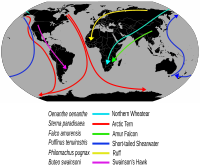
Photo from wikipedia
Extracting true amplitude versus angle common image gathers is one of the key objectives in seismic processing and imaging. This is achievable to different degrees using different migration techniques (e.g.,… Click to show full abstract
Extracting true amplitude versus angle common image gathers is one of the key objectives in seismic processing and imaging. This is achievable to different degrees using different migration techniques (e.g., Kirchhoff, wavefield extrapolation, and reverse time migration techniques) and is a common tool in exploration, but the costs can vary depending on the selected migration algorithm and the desired accuracy. Here, we investigate the possibility of combining the local-shift imaging condition, specifically the time-shift extended imaging condition, for angle gathers with a Kirchhoff migration. The aims are not to replace the more accurate full-wavefield migration but to offer a cheaper alternative where ray-based methods are applicable and to use Kirchhoff time-lag common image gathers to help bridge the gap between the traditional offset common image gathers and reverse time migration angle gathers; finally, given the higher level of summation inside the extended imaging migration, we wish to understand the impact on the amplitude versus angle response. The implementation of the time-shift imaging condition along with the computational cost is discussed, and results of four different datasets are presented. The four example datasets, two synthetic, one land acquisition, and a marine dataset, have been migrated using a Kirchhoff offset method, a Kirchhoff time-shift method, and, for comparison, a reverse time migration algorithm. The results show that the time-shift imaging condition at zero time lag is equivalent to the full offset stack as expected. The output gathers are cleaner and more consistent in the time-lag-derived angle gathers, but the conversion from time lag to angle can be considered a post-processing step. The main difference arises in the amplitude versus offset/angle distribution where the responses are different and dramatically so for the land data. The results from the synthetics and real data show that a Kirchhoff migration with an extended imaging condition is capable of generating subsurface angle gathers. The same disadvantages with a ray-based approach will apply using the extended imaging condition relative to a wave equation angle gather solution. Nevertheless, using this approach allows one to explore the relationship between the velocity model and focusing of the reflected energy, to use the Radon transformation to remove noise and multiples, and to generate consistent products from a ray-based migration and a full-wave equation migration, which can then be interchanged depending on the process under study.
Journal Title: Geophysical Prospecting
Year Published: 2018
Link to full text (if available)
Share on Social Media: Sign Up to like & get
recommendations!